Limassol’s tourism boom started after 1974, when the main tourist destinations of Cyprus, Famagusta and Kyrenia, were taken in the Turkish invasion of Cyprus, and became part of Northern Cyprus. Limassol boasts several beaches ideal for sunbathing and swimming. The Cyprus Tourism Organisation (CTO) operates a bathing beach with all required amenities in the Dasoudi neighborhood of Limassol.
Limassol was designated as the Republic of Cyprus’s primary seaport in 1974. Prior to 1974, the position was provided by Famagusta, presently situated in Northern Cyprus and not recognized as a lawful port by any nation save Turkey.
Many of the island’s wineries have their headquarters in Limassol, servicing the wine-growing districts on the southern slopes of the Troodos Mountains (of which the most famous is Commandaria). KEO, LOEL, SODAP, and ETKO are the most significant. The wines and cognacs (brandies) made from grapes grown in the countryside are of exceptional quality. They have received several honors at international exhibits. Locals and international tourists both consume a significant amount of wine goods in Cyprus. Large amounts are sent to Europe.
Limassol is the province’s most important industrial center. There are around 350 industrial units and 90 industry goods. These industries include dressmaking, furniture, shoes, beverages, cuisine, printing, metal industry, electric gadgets, plastic products, and many more.
Limassol is an important commercial center in Cyprus. This is due to the existence of the UK sovereign base in Episkopi and Akrotiri, as well as the population relocation in Limassol after the Turkish assault in 1974. The trade markets are concentrated in the town center and along the shore, beginning at the ancient port and ending in the Amathus district. This neighborhood contains the majority of the hotels, restaurants, confectioneries, discos, and other places of amusement.
Limassol has two ports, known as the “old port” and the “new port.” The new port has the highest commercial and passenger traffic volume and is the largest port in the Republic of Cyprus. The historic harbour features a barrier that is 250 meters (820 feet) long and can only accommodate three small ships at a time. As a result, fishing boats often utilize it. The new port is 11 meters (36 feet) deep and contains 1,300 meters (4,300 ft) of breakwaters. It can accommodate up to 10 ships, depending on their size. These ports export and import grapes, wines, carobs, citrus fruits, as well as grains, automobiles, machineries, textiles, agricultural medications, fertilizers, iron, and other goods.
Limassol is now Europe’s largest ship management service center, with more than 60 ship management companies based there, thanks to the Cyprus Shipping tax system (a choice between corporation tax and a tonnage tax system), which makes it very appealing for ship management companies to have their main offices in Limassol. Thus, the extremely popular MARITIME CYPRUS shipping conference, which takes place every two years and attracts all of the world’s top shipping corporations. More than 40.000 seamen are now employed by these ship-management businesses. In fact, the Cyprus register is now rated eighth among foreign fleets.
A marina has been erected to the west of Limassol Castle, between the ancient and new ports. This new building, which permits ocean-going boats to dock, opened to the public in 2014 after hosting its first ships in 2013. The marina can accommodate 1,000 yachts.
Limassol has seen a development boom in recent years, fueled by the tourism industry as well as increased foreign investment in the city. Public initiatives, such as the remodeling of the city’s one-kilometer (0.62-mile) promenade, are increasing people’s quality of life and the city’s image as a cosmopolitan destination. Infrastructure upgrades financed in part by European programs have aided the city in resolving traffic issues caused by the installation of new highway flyovers and roundabouts.


